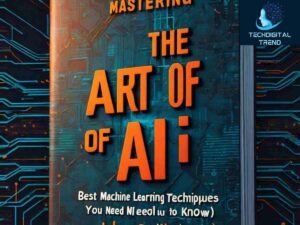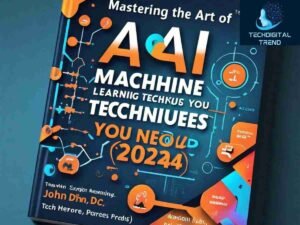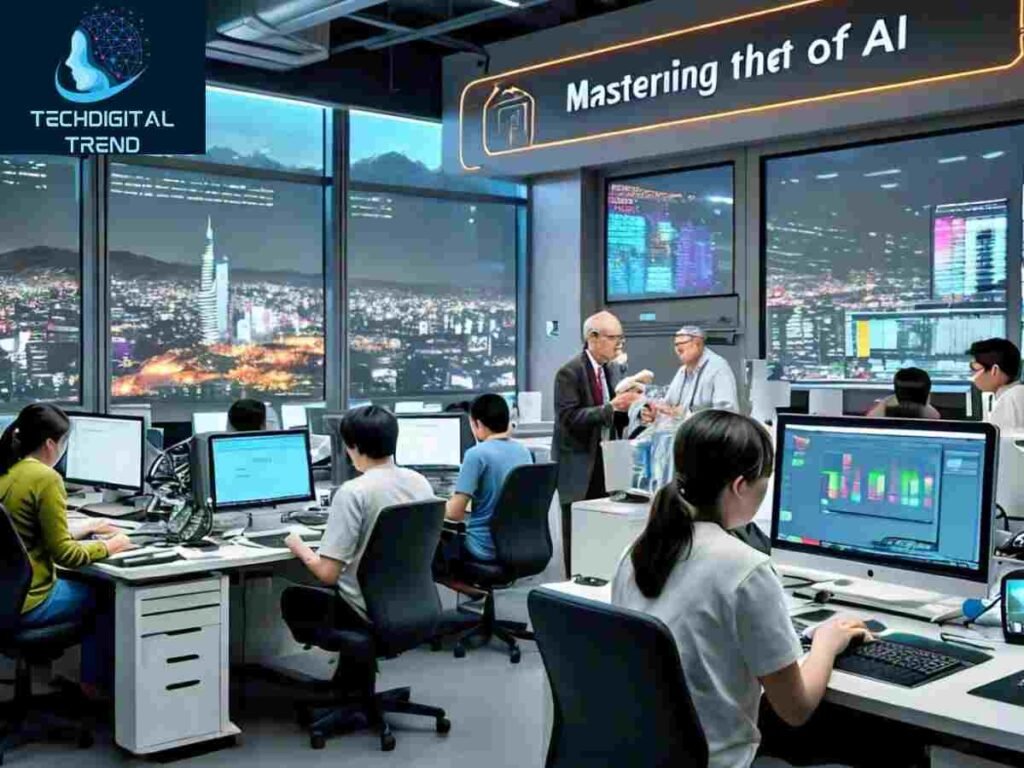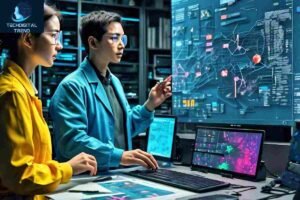Table of Contents
ToggleLearning Techniques
Introduction to Machine Learning Techniques
Machine learning techniques, a subset of AI, empower computers to learn from data, discern patterns, and make decisions autonomously. Think of it as teaching a child to recognize shapes and colors by showing them pictures rather than reciting definitions. By training machines to learn from experience, we equip them with the ability to adapt and evolve, paving the way for groundbreaking innovations across various domains.
The concept of machine learning techniques revolves around algorithms – mathematical models that process data and extract meaningful insights. These algorithms are trained using labeled datasets, where each data point is accompanied by a corresponding outcome. Through iterative learning, machines adjust their internal parameters to optimize performance, gradually improving accuracy and predictive capabilities.
The three main classifications of algorithms used in machine learning are supervised learning, unsupervised learning, and reinforcement learning.
Supervised Learning Techniques
- Supervised learning techniques is akin to a guided learning process, where machines are presented with labeled data and tasked with predicting outcomes based on input variables. Imagine a teacher guiding a student through practice exams, providing feedback on correct and incorrect answers. Similarly, supervised learning algorithms analyze historical data to identify patterns and relationships, enabling them to make accurate predictions on new data.
- Supervised learning encompasses various algorithms, including linear regression, logistic regression, decision trees, random forests, and support vector machines (SVMs). Each algorithm has its strengths and weaknesses, making it suitable for different types of tasks, such as classification, regression, and anomaly detection.
Unsupervised Learning Techniques
- Unsupervised learning techniques takes a more exploratory approach, allowing machines to uncover hidden patterns and structures within unlabeled data. Unlike supervised learning techniques, where the algorithm is given explicit instructions, unsupervised learning algorithms are left to their own devices, clustering data points based on similarities and differences. It’s like solving a mystery without knowing the culprit – the algorithm must decipher clues and draw conclusions without guidance.
- Common unsupervised learning techniques include clustering algorithms like K-means clustering, hierarchical clustering, and density-based clustering. These algorithms group similar data points together based on their intrinsic characteristics, revealing underlying patterns and structures within the data.
- Dimensionality reduction techniques, such as principal component analysis (PCA) and t-distributed stochastic neighbor embedding (t-SNE), are also used in unsupervised learning to reduce the number of features in high-dimensional datasets while preserving essential information.

Reinforcement Learning Techniques
- Reinforcement learning mimics the process of trial and error, where machines learn by receiving feedback on their actions. Similar to training a pet with treats and punishments, reinforcement learning algorithms receive rewards or penalties based on their decisions, learning to maximize rewards over time. This dynamic approach enables machines to adapt to changing environments and optimize decision-making in complex scenarios.
- Reinforcement learning has applications in various domains, including robotics, gaming, finance, and healthcare. For example, reinforcement learning algorithms can be used to train autonomous agents to navigate through challenging environments, play video games at human-level performance, or optimize financial trading strategies.
Neural Networks
- Neural networks are the cornerstone of deep learning, drawing inspiration from the structure and function of the human brain. These interconnected networks of artificial neurons process information through layers of computation, learning complex patterns and representations. From image recognition to language translation, neural networks power a wide range of AI applications, revolutionizing industries and reshaping the future of technology.
- Deep learning architectures, such as convolutional neural networks (CNNs), recurrent neural networks (RNNs), and generative adversarial networks (GANs), have demonstrated remarkable success in various tasks, including image classification, natural language processing, and speech recognition. By leveraging hierarchical feature learning learning and large-scale data, deep learning algorithms achieve state-of-the-art performance in many domains.
Deep Learning
- Deep learning extends the capabilities of neural networks by introducing multiple layers of abstraction, enabling hierarchical feature learning. It’s like peeling layers of an onion to reveal increasingly nuanced insights – each layer extracts higher-level representations from raw data, enabling machines to discern intricate patterns and relationships. With advancements in hardware and algorithms, deep learning has emerged as a game-changer, fueling innovations in areas such as healthcare, finance, and autonomous vehicles.
- Deep learning models require vast amounts of labeled data and computational resources for training, making them suitable for large-scale applications with access to significant computing power. Transfer learning and pre-trained models are also commonly used in deep learning to leverage knowledge from existing models and adapt them to new tasks with limited data.
Decision Trees
- Decision trees offer a simple yet powerful approach to decision-making, resembling flowcharts that map out possible outcomes based on input variables. Each decision node represents a choice, while leaf nodes denote final outcomes, making decision trees intuitive and easy to interpret. By partitioning data into smaller subsets based on feature values, decision trees enable machines to classify and predict outcomes with remarkable accuracy.
- Decision trees can be visualized and understood easily, making them ideal for explaining complex decision-making processes to non-technical stakeholders. However, decision trees are prone to overfitting, especially with noisy or high-dimensional data, necessitating learning techniques like pruning and ensemble methods (e.g., random forests) to improve generalization performance.
Support Vector Machines
- Support Vector Machines (SVMs) are versatile algorithms used for classification and regression tasks, particularly in scenarios with complex decision boundaries. SVMs excel at finding the optimal hyperplane that separates different classes in the data, maximizing the margin between them. This margin-based approach not only improves generalization performance but also enhances robustness against noise and outliers in the data.
- SVMs are widely used in various domains, including image classification, text classification, and financial forecasting. Their ability to handle high-dimensional data and nonlinear decision boundaries makes them suitable for a wide range of applications, from sentiment analysis and spam detection to medical diagnosis and stock market prediction.
Clustering Techniques
- Clustering techniques group similar data points together based on their intrinsic characteristics, uncovering hidden structures within the data. It’s like organizing a jigsaw puzzle, grouping pieces with similar shapes and colors to form coherent patterns. From customer segmentation to anomaly detection, clustering algorithms play a crucial role in data exploration and pattern recognition, offering valuable insights into complex datasets.
- Common clustering algorithms include K-means clustering, hierarchical clustering, DBSCAN (Density-Based Spatial Clustering of Applications with Noise), and Gaussian mixture models (GMMs). These algorithms can be used to identify clusters, outliers, and patterns in diverse datasets, enabling businesses to gain actionable insights and make data-driven decisions.

Dimensionality Reduction
- Dimensionality reduction techniques aim to simplify complex datasets by reducing the number of features while preserving essential information. By eliminating redundant or irrelevant features, dimensionality reduction algorithms enhance model interpretability and computational efficiency. It’s like summarizing a lengthy document into key bullet points, distilling the essence of the data while discarding noise and redundancy.
- Principal component analysis (PCA), t-distributed stochastic neighbor embedding (t-SNE), and autoencoders are popular dimensionality reduction techniques used in machine learning and data analysis. These learning techniques transform high-dimensional data into a lower-dimensional space while retaining as much variance or information as possible, facilitating visualization, exploration, and analysis of complex datasets.
Natural Language Processing
- Natural Language Processing (NLP) empowers machines to understand, interpret, and generate human language, opening up a world of possibilities for AI-driven communication. From virtual assistants like Siri and Alexa to sentiment analysis and language translation, NLP enables machines to interact with humans in natural, intuitive ways. By analyzing text data and extracting semantic meaning, NLP algorithms facilitate a wide range of applications across industries.
- NLP encompasses various tasks, including text classification, named entity recognition, sentiment analysis, machine translation, and question answering. State-of-the-art NLP models, such as transformer-based architectures like BERT (Bidirectional Encoder Representations from Transformers) and GPT (Generative Pre-trained Transformer), have achieved remarkable performance on benchmark tasks, pushing the boundaries of language understanding and generation.
Computer Vision
- Computer vision enables machines to perceive and interpret visual information from the real world, revolutionizing fields such as healthcare, manufacturing, and autonomous navigation. From facial recognition and object detection to medical imaging and augmented reality, computer vision systems empower machines to understand and interact with the visual world. By analyzing pixel data and extracting meaningful features, computer vision algorithms unlock new opportunities for innovation and automation.
- Convolutional neural networks (CNNs) are the backbone of modern computer vision systems, leveraging hierarchical feature learning techniques to extract spatial hierarchies and patterns from images. Transfer learning and fine-tuning techniques allow computer vision models to be adapted to various tasks with minimal data and computational resources, accelerating the development of real-world applications.
Conclusion
Mastering the art of AI and its machine learning techniques is not merely a technical pursuit but a journey of exploration and discovery. Whether you’re a novice or a seasoned professional, delving into the world of AI opens doors to endless possibilities, from solving complex problems to driving innovation and transformation. By understanding the principles and applications of machine learning, you can harness the power of AI to tackle challenges, unleash creativity, and shape the future of technology.
How can I keep up with the most recent developments in artificial intelligence and machine learning techniques?
Keeping abreast of the rapidly evolving field of AI and machine learning techniques requires continuous learning and exploration. Engaging with online communities, attending conferences and workshops, and following reputable sources such as research papers and industry blogs can help you stay informed about the latest developments and trends.
Are there any ethical considerations to keep in mind when working with AI?
Yes, ethical considerations such as privacy, bias, and transparency are crucial when developing and deploying AI systems to ensure they benefit society responsibly. It’s essential to consider the potential impact of AI technologies on individuals, communities, and society as a whole, and to design and implement AI solutions ethically and responsibly.
Open this link: Tap to here














